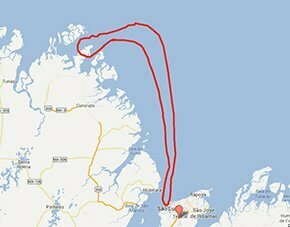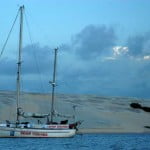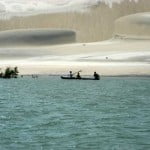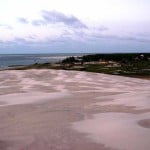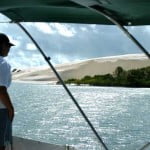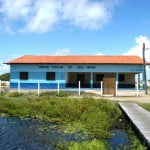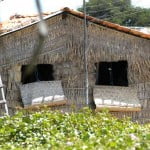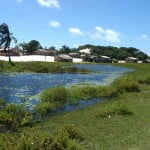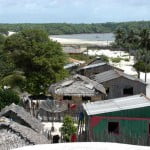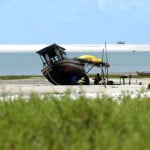Wednesday, 08 – 06 – 05
We left at dawn towards the Lençois island, situated 90 miles north.
Yesterday afternoon, after we had arrived from São Paulo, we managed to go to Maranhão’s Federal University to talk to Professor Antonio Carlos Leal, who specializes in hydrobiology and oceanography. He confirmed the previous information we had on the threats caused by the pollution on the São Marcos bay, whose waters bathe the capital. Alunorte, which processes aluminum among other metals, and the port system on the Rio Doce Valley are the big villains this time. Settled in the 80’s, both companies chose to establish themselves on the São Luis island, at an environmentally vulnerable spot, especially because of its proximity with the port, which in turn probably helps them cut down on costs. However, from an environmental point of view, things couldn’t be worse since the occupied area is surrounded by canals, rivers and swamps, where some of its rejects and effluents end up. Besides, several fishing communities had to be removed while the huge industrial complex was being built, which has also brought about social problems in this region.
The professor mentioned another threat besides the pollution: the constant dredging in the canal that accesses the port, which makes the sea currents deeper and so they move faster, causing erosion on the shores.
Finally, he emphasized that the entire bay is packed with ships (in a 2003 survey, the Itaqui port was the second biggest port in the country in terms of payload shipping, moving 68 million tons, after Tubarão, in Vitoria, ES, which moves 76 million. Source: Annual of Transportation Statistics – Geipot). Besides, there is no reduction plan for potential oil leaking accidents. In his opinion, the bay’s degradation process is evident, as shown by the great decrease of micro organisms and other animals at the beginning of the reproduction chain.
When I told the professor that I had some data from the book “Profile of Brazil’s Coastal States” , a study done by the government to implement the 1996 National Program for Coastal Management, about the fact that 17% of the homes in São Luis had adequate waste water treatment systems, he just smiled, and said that 0% would be the right statistics, since the only two sewer treatment stations built in São Luis were never inaugurated. Thus, the São Marcos bay has to put up with the dejects of nearly one million people, thrown mainly in the Anil and Bacanga rivers, both of which discharge into the bay.
Professor Leal is skeptical about the future. He points out that an iron and steel industry financed with investments from Japan is about to settle in the area. Due to all these factors, he feels that in 5 or 10 years the São Marcos bay may be as polluted as the Sepetiba bay in Rio de Janeiro.
Having all these worries on our mind, we headed towards the bay at dawn.
As we went past the bar, there were about 20 huge ships waiting to tie up. I wondered how many thousands of exotic microorganisms are brought by these monsters’ ballast waters, most of which inevitably swept back into the ocean after each journey.
In Maranhão, fortunately, the big menaces are right here in the Maranhão Gulf. There are not many industries in the north and south regions, only manual fishing and mining activities, and farming of mostly “babaçu”, rice, corn, manioc and cotton plantations.
Another surprise, to me at least: according to the professor, there is no industrial fishing in Maranhão. There simply aren’t any fishing boat fleets. The only ones you can see around here, already mentioned in my previous log, are the beautiful boats built by hand, made of various sizes and types, moved mostly by sails, and used for manual transportation and fishing.
Nevertheless, in this state, the second largest in Brazil, the 640 kilometers on the coast are frequented by industrial fleets from Ceará and Pará.
Indeed, while sailing up to here, we only saw fishing boats from these two states. Whenever any boat from Maranhão is spotted, it is always one of the typical vessels made by artisans.
On our long trip to the Lençois island, we didn’t cross any boats of any type. It was a smooth journey. We had the engine on most of the time since the east-southeast wind was not strong enough to push “Endless Sea”. By late afternoon, as we were about to arrive, it picked up from 1-11 to 15-18 knots, at which point we turned off the engine and raised our three sails: the ”genoa” at the bow, the master sail in the center, and the mizzen sail, a smaller stern sail. Having the three sails up, we silently sailed our last 15 miles of the journey, moving slowly through the Lençois bay, surrounded by islands on the Maiaú archipelago, among them lying the most emblematic one, the one that has brought us here: the Lençois island. We anchored in the west, where there is more protection from strong winds. After a lavish dinner, and feeling exhausted by the trip, we all hit the sack. We’ll be doing some exploring of the surroundings tomorrow, so everyone has to be rested.
Thursday, 09 – 06 -05
Right at sunrise, we moved “Endless Sea” into the river surrounding Lençois, then anchored again, this time closer to the village, at a place called “little port”, behind a huge dune.
Around 350 people live on the island, most of whom fish for a living, the only thing they can do here. The soil is composed of dunes and lagoons, so there are no plantations, not even small ones such as those in the caiçara villages. Lençois has two very special characteristics: due to same-blood marriages, there is a great number of albinos. A 1970 census showed this albino community as the biggest one in the world. The other strong characteristic is that most of the population is Sebastianist. They believe Don Sebastian is an enchanted entity who dwells in the surroundings. At full moon, he supposedly turns himself into a bull or a horse, and strolls on the dunes around the island.
Unfortunately we have new moon tonight, which means our crew will not have the chance to confirm this legend.
Early in the morning it was already very hot, despite the stronger winds. Since work came first, we got all set, took our equipment, and set off to our first filming session. We knew there was only one pousada, a small hotel whose manager was from São Paulo. We looked him up as soon as we got to town and asked him to help us contact some elderly citizens who would be willing to speak to journalists. However, the pousada was closed – the owner had traveled to São Luis. We managed to get the information we needed, though, and pretty soon we were interviewing an elderly man named Zé Mario, who was a spiritualist medium (“pai-de-santo”). He’s part of the one family who has lived on the island for three generations, and he confirmed the information on the Sebastianist legend and the population’s beliefs.
He met with us at his house, a very simple, neat and well-taken care of wooden cottage built on dirt. While we were chatting, other dwellers arrived, looking at us curiously. Among them were two of Zé Mario’s grandchildren, two 5-8 year-old albino boys. Being less shy, they entered the room and started moving around us silently, staring at our filming and photography equipment, as if we were creatures from another planet. The older people, however, would stand by the doors and windows, not daring to approach, though they also seemed to be curious about us. It is not that easy to gain these people’s trust. They often resent our presence, as if their lives were being invaded by “these exotic beings”, and lock themselves up in their homes. We had to be quite diplomatic not to scare them, to make sure our presence, especially our reporter Paulina’s, wouldn’t affect their natural and spontaneous personalities, jeopardizing the interviews.
However, of all Paulina’s talents – she has many – her greatest one is how well she can approach people and “break the ice”. Pretty soon she had already conquered the whole group’s trust, keeping an open, natural conversation with everyone.
Afterwards, we went sightseeing. The village is composed of two or three sand roads, if one may call them roads, surrounded by dunes, some palm trees, and a few cashew trees here and there. Most houses are made of wood and have their roofs thatched with sape grass, although some are 100% built with straw thatched from palm tree leaves, which gives them a peculiar style. I’d never seen anything like it. The only brick construction is the kids’ school.
During our tour we tried to approach other townsmen who were known as good tellers of popular stories, but we noticed they were a bit reticent, so we respected their privacy and saved the interviews for another time.
We were happy enough with our tour. We were accompanied by Colo (a short name for Collor) and Furo, two teenage brothers who became our guides when we left Zé Mario’s house.
Finally, we went for a glass of ice water at one of the few bars on the island. It was unbearably hot, so the shade came in handy. For about half an hour, we hung out there chatting with the owner, Laura, a nice, talkative lady. She offered to take us to visit another emblematic character, an elderly man who knew the local traditions. We’d have to go later on, though, because in the middle of the day, said Laura, when it’s very hot, people would rather be home, lying on their hammocks, waiting for late afternoon time, when the temperature gives everyone a break and drops a bit.
We went to have lunch on the “Endless Sea”. Everyone was stunned by the beauty of the place. There are canals everywhere, the greenest swamps, high dunes, small islands all next to each other, beaches, warm waters, and lots of wind.
After lunch we set off to the Maiau island, which bears the same name as the archipelago. Bate Vento, a village bigger than Lençois, is the main town there.
We noticed its population is not only larger than in most towns, but also more outgoing and cheerful.
A women’s soccer game was taking place when we got there. They were practicing with some kids for Saturday’s great tournament, when another women’s team from Lençois was competing with them.
They were very nice to us. The girls let themselves be filmed, gave interviews, and even participated in some intros for the program.
We filmed the outskirts of the town exhaustively, finishing up one more program almost completely.
Tomorrow we’re going to try to interview another character from Lençois who is supposed to know the local traditions, and after that we should be heading to Cururupu, our next stop.
Friday, 10 – 06 – 05
It was a spectacular night. Since there´s a new moon, there’s very little light in the sky, so thousands of stars shine in front of our eyes. It’s a fantastic experience to be able to enjoy a place like this, surrounded with so much beauty, beginning with the sky.
It poured the whole night when we went to bed, even though the sky was packed with stars. We were awoken by the rain drops falling through the gaiutas ( a type of roof window in the boat cabins and resting room).
The sun finally rose, and we were welcomed by another windy, sunny day. After breakfast, we went to town, met our friend Laura and together, we went to see Mr. Piedade, a 78-year-old man who had so many children he had to count in his fingers when we asked him how many they were so he wouldn’t forget anybody, including an endless number of grandchildren.
Once again, Don Sebastian’s stories came up, followed by other enchanted people’s tales. As soon as we fulfilled our agenda, we had lunch and pulled anchor.
We didn’t get very far, only far enough to notice it was quite rough out at sea. The strong, southeast 20-25 knot wind was hitting the bow from up front. It looked like the sea was about to get very rough, which made it risky to enter a very stilted bar that was much narrower than the one in Lençois . We were supposed to have only two hours of day light so it was not worth moving on. We’d better spend the night somewhere close to the exit, and try leaving at dawn tomorrow. Who knows if the wind won’t have given us a break by then?
Saturday, 11 – 06 – 05
This morning we followed a fishing boat that was going to Carupuru through a “hole” ( a narrow channel) which we didn’t even know existed, since it is not mentioned in the navigation chart. We crossed the Lençois bay and, as we entered the channel, we spotted another fishing village, named Porto Alegre, so we decided to stop for a visit. It’s a very interesting place. Dozens of fishing boats, most of them small sailing canoes, were getting ready to leave. We noticed how smoothly they could be maneuvered, their sails hoisted and set to sea. It’s amazing how simple and efficient those canoes can be. Besides, they are so beautiful, with their huge and colorful sails. They can get set up to face the strong local winds in no time. Some of them remain in the lagoons, anchored almost in front of the fishermen’s homes.
We didn’t stay there long because we wanted to cross the channel at high tide, so we moved on.
We sailed another few miles and pretty soon, as low tide began to drain, the channel became too narrow to cross. We were right by another village whose name was kind of interesting: “Valha-me Deus” ( God forbid!). We decided to spend the night and cross the channel the next day.
We took the opportunity to get to know the people and visit the area. Even though “Valha-me Deus” is surrounded by palm and mango trees that give great shade, it was a very hot day. We couldn’t resist going for a nice bath in a lagoon nearby, since showers on board are rationed because it is difficult to supply “Endless Sea” with fresh water.
Afterwards, we interviewed some townsmen, who were always nice conversationalists, and who showed constant curiosity about our journey and the boat. Both here and in Lençois, they told us about the new issue that is beginning to bother them: real state speculation.
It turns out the Maranhão government has started an ecological tourism plan for this region. As a start, they named the area “The Guarás Forest” because they have guarás everywhere, which attracts tourists.
Also, there are ongoing studies about the optimal conditions to build a tourism complex here in the future. According to locals, once in a while outsiders enquire about land prices, although not very often. As a matter of fact, the islands are state property so these plots of land cannot be sold. Locals who have lived here a long time may, at most, claim the land…. Still, speculation is beginning to take place, albeit slowly. We were told that once in a while people from town ask about prices, among them the Cururupu mayor, who seems to have “purchased” one of the islands nearby. This is a true inversion of values. Those who are supposed to protect these humble people, who have been elected to do so, end up taking advantage of their ingenuity, trying to make investments for their own future, when more infra-structure will be offered, making land prices definitely rise. I’ve been there before! The same thing has happened on a famous island on the São Paulo coast. I’m talking about Ilhabela, whose mayor is being accused of becoming a partner in a real state company soon after being elected. They now sell land which belongs to the State Park, such as the lots on top of the hills or by the shore. What a nerve! In Ilhabela, at least, people reacted strongly against it, and the mayor was close to being impeached. At the moment he’s managed to remain in office through a preliminary…
Sunday, 12 – 06 – 05
We scheduled our departure according to the tide, so this time we managed to cross the narrow channel that took us to the Guajerutiua bay, where we anchored in front of the village bearing the same name. Besides Lençois, this is undoubtedly one of the most beautiful places we’ve been to until now. The beaches are huge, the sand is white, the village surrounded by palm trees, and there are lots of fishing boats.
It was Sunday. People were out on the streets enjoying their day off when we got there, most of them socializing outdoors or partying at bars and saloons where parties take place. In the background, very loud music blasted out.
As soon as we got off the boat, we were escorted by two boys who became our guides. It’s always like that. The minute we set foot on the ground, the local kids run towards us to show the best their village can offer.
It couldn’t be different this time. Right off the bat the boys told us about a family whose pet is a very bright bird, a “japú” . It has a habit of flying into people’s homes and take whatever it can in its beak: toothbrushes, pacifiers, cigarettes, and especially money. The boys said that, if you offer a japú a sheet of paper in one hand and money in the other, it won’t hesitate in taking the bill, of course. We went there to check it out and it was really true. We talked to the whole family – just like everyone else, they all make a living on fishing.
After that we visited an artisan who builds handmade boats – his backyard is his shipyard. He was building a “curicaca”, a type of canoe moved by sails.
Conversation with these folks is always fun, spontaneous and pleasant. It’s amazing how simple they are, and how they can live on so little. We spent the whole afternoon visiting the surroundings, and went back to “Endless Sea” at the end of the day.
The next day, we’d have another 80 miles to go to get back to São Luis. Two more programs had just been concluded, therefore we’d met our objectives on that trip.
Monday, 13 – 06 – 05
When the sun rose, we had breakfast, lifted the rubber lifeboat onto the “turco” (a type of crane on the boat’s stern), pulled anchor and set off to sea.
This time it was easier to cross the Guajerutiua bar, which is quite wide, and not as silted up as the other ones so far. After navigating for two hours we were already at open sea, the southeast wind blowing strongly, hitting our bow from up front, pushing the boat towards São Luis.
We didn’t have a very pleasant time at first. The sailboat kept pitching (swinging longitudinally), going violently up and down the waves due to the strong wind. The easy time we had had since we’d got on the Oiapoque river at the Brazil-French Guyana border was now over. We had started our adventure in December, when it is winter in the northern region, and not too windy. But as summer starts in June, it’s another story, and the southeast wind is pretty tough. It starts blowing in the morning, at a constant rate of, at least, 20 knots.
As each wave drops, the bow hits the next wave, splashing water sidewise, getting the whole crew soaked all the time. It’s pretty unpleasant, though we can’t avoid it. All we can do is hope the cross current is not too strong….
From now on, until we get to Rio Grande do Norte, the weather will always be like this. To make up for it, as of Natal, we should be again sailing at tail wind and current.
This is what the trip on the way back was like. We rocked up and down the waves until almost 10 p.m., when the wind shifted slightly to the east , which enabled us to raise sails and move on more smoothly.
By midnight we were crossing the Itaqui port access channel. At 2:30 a.m. everyone was soaking wet, feeling exhausted but happy for having fulfilled one more stage. Once again, we anchored in front of the São Luis Yacht club.
On our next trip, by late June, we should be leaving São Luis towards the south. We plan to go down the Preguiças river, which accesses Barreirinha, the closest town to famous Lençois Maranhenses. After that, we’ll be reaching the Parnaiba river delta, making a stop in Parnaiba, a town already in the fourth state on our trip: Piauí.


